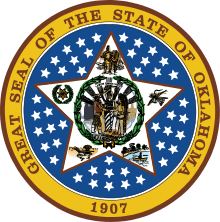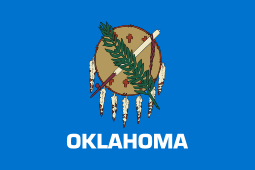Oklahoma Historical Society
|
Great Seal of Oklahoma | |
| Agency overview | |
|---|---|
| Formed | May 1893 |
| Headquarters |
800 Nazih Zuhdi Dr. Oklahoma City |
| Employees |
156 classified 12 unclassified |
| Annual budget | $20 million |
| Minister responsible |
|
| Agency executive |
|
| Website | Oklahoma Historical Society |
The Oklahoma Historical Society (OHS) is an agency of the government of Oklahoma dedicated to promotion and preservation of Oklahoma's history and its people by collecting, interpreting, and disseminating knowledge and artifacts of Oklahoma.
The Society has the rare distinction of being both a Smithsonian Institution and National Archives and Records Administration affiliate.
History
OHS was formed in May 1893, 14 years before Oklahoma became a state, by the Oklahoma Territorial Press Association. The initial function of OHS was to collect and distribute newspapers published in Oklahoma Territory. The Society was declared an agency of the territorial government in 1895, and it became an official state government agency when Oklahoma reached statehood in 1907. OHS is both a private, membership organization and an Oklahoma government agency. The OHS Board of Directors is made up of 25 members, 12 of whom are appointed by the governor and 13 elected by OHS members to three-year terms.[1]
Functions
OHS today works statewide and nationally to preserve and nurture Oklahoma's history. The Oklahoma State Historic Preservation Office, also operated by the Society, carries out federal preservation programs in Oklahoma under the National Historic Preservation Act, to preserve Oklahoma's significant buildings, parks, objects, and sites. Projects are carried out in partnership with the Department of the Interior and the National Park Service, as well as other state and local governments, groups, and interested people. The society posts markers at historical sites.
Publications
OHS has published The Chronicles of Oklahoma, the Society's scholarly journal, since 1921 and continues to issue four editions per year. The Society's monthly newsletter, Mistletoe Leaves, includes information about OHS activities and historical happenings throughout Oklahoma. Both publications and other historical works are available by subscription or per issue. OHS has also published numerous other titles including The Encyclopedia of Oklahoma Culture and History.
The Chronicles of Oklahoma through 1962 and The Encyclopedia of Oklahoma Culture and History are available online through the Oklahoma State University Library Electronic Publishing Center.
Archives and Collections
OHS Research Division collections include 9 million photographs, more than 1 million pages of historical documents and manuscripts, 3,000 oral histories, historic film and video collections, and more than 4,400 titles of newspapers on available microfilm.
Many of the Oklahoma Historical Society's documents and materials are available online at little or no charge, including indexes to the Dawes Rolls, Oklahoma military deaths, the 1890 Oklahoma Territorial Census, Territorial Incorporation Records, Hastain's Township Plats of the Creek Nation, Oklahoma County marriage records 1889-1951, Daily Oklahoman obituaries, and Smith’s First Directory of Oklahoma Territory. The online archives catalog also contains some of the photographs in the OHS Research Division Collection. Historic newspapers are available free of charge on the Society's Gateway to Oklahoma History.
Museums
Oklahoma History Center
The Society operates the Oklahoma History Center, the state's museum located in Oklahoma City. The History Center occupies 215,000 ft² (19,974m²) and contains more than 2,000 artifacts and exhibits featuring hands-on audio, video, and activities. A museum store is available online or at the History Center, and annual membership can be purchased for individuals, families, and institutions.
From 1919 to 1942, Czarina Conlan was in charge of collecting artifacts and documents for the museum from the various Native American tribes throughout the state.[2][3] The History Center also houses the OHS Research Division, which includes a large Research Center that is free and open to the public.
Oklahoma Museum of Popular Culture (OKPOP)
In May 2009 the Society announced plans to build a second museum, to be called the Oklahoma Museum of Popular Culture, or OKPOP, and located in Tulsa's Brady District. It is planned as the state museum of popular culture, including music, television, film and the performing arts.[4]
Other Facilities
The Historical Society also administers a number of state-owned properties either in their entirety or with interpretive centers.:[5]
- Museums
- Cherokee Strip Museum
- Cherokee Strip Regional Heritage Center
- Museum of the Western Prairie
- Oklahoma Territorial Museum
- Route 66 Museum
- Pioneer Heritage Townsite Center
- Pioneer Woman Museum
- Spiro Mounds
- Historic Homes
- Pawnee Bill Ranch
- Peter Conser Home
- Fred Drummond Home
- George M. Murrell Home
- Frank Phillips Home
- Sequoyah's Cabin
- Sod House
- Military Sites
Leadership
The Oklahoma Historical Society is under the supervision of the Secretary of Commerce and Tourism. Under Governor of Oklahoma Mary Fallin, Larry Parman is serving as the Secretary.
Board of Directors
The Society is governed by a 25-member Board of Directors. Thirteen of those members are elected by the members of the Society and twelve are appointed by the Governor of Oklahoma, with the approval of the Oklahoma Senate. All member serve three-year terms. The Governor also serves as an ex officio member of the Board. The Board is responsible for appointing an Executive Director of the Society, who serves concurrently as the State Historic Preservation Officer. The current Executive Director is Dr. Bob L. Blackburn, Ph.D..
References
- ↑ "Historical Society, Oklahoma Board" (PDF). Oklahoma State Government Online. Oklahoma Department of Libraries. 2007. Retrieved May 23, 2007.
- ↑ "Indian Women of Oklahoma Active Workers in Clubs". Decatur, Illinois: The Decatur Daily Review. AP. December 13, 1927. p. 14. Retrieved 8 August 2016 – via Newspapers.com.

- ↑ "State Briefs". Miami, Oklahoma: The Miami Daily News-Record. February 23, 1942. p. 5. Retrieved 9 August 2016 – via Newspapers.com.

- ↑ Randy Krehbiel, "New Tulsa museum announced by Oklahoma Historical Society", Tulsa World, May 19, 2009.
- ↑ "Museums & Historic Sites". Oklahoma Historical Society. Retrieved 2014-02-01.
External links
- Oklahoma Historical Society official site
- OHS Gateway to Oklahoma History
- Oklahoma History Center official site
- OKPOP official site

